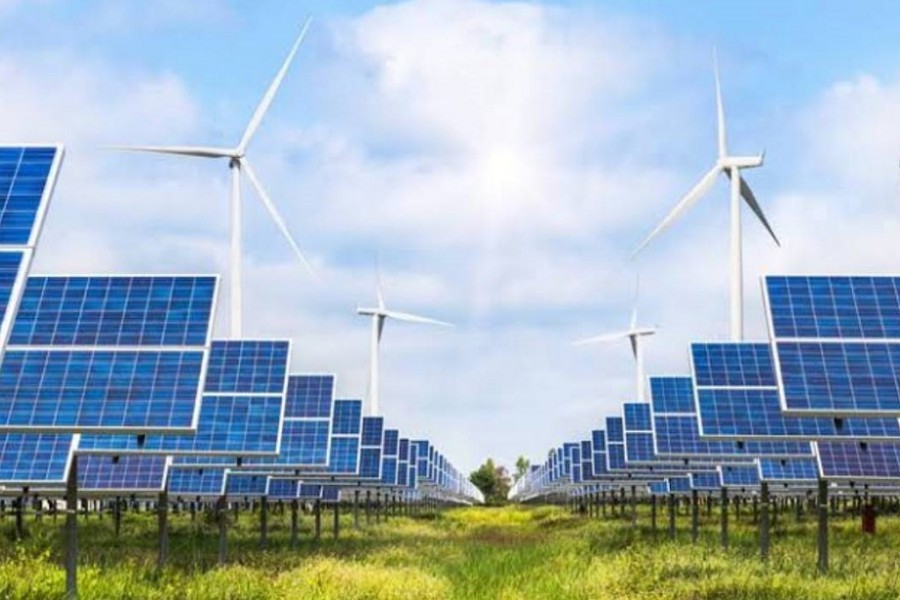
Published :
Updated :

The global energy market volatility during the Russia-Ukraine war has exposed at least two things: (i) dependence on fossil fuel supplied far away from national boundaries; and (ii) a lack of or inadequate energy cooperation among the closed neighbours, especially in the context of Bangladesh's immediate vicinity.
While cooperation is a natural imperative for the countries in the downstream of the Himalayas, they have also been blessed with scope for exploring energy sources that do not harm the environment. The potential of hydroelectricity, for example, remained largely unutilised over the decades and that of solar power is yet to be exploited properly for greater benefits of the people in each country and beyond the borders.
Geographical proximity of Nepal and Bhutan with two of their downstream countries - India and Bangladesh - has made their natural environment and economic fates interconnected. Sunlight, rainfall, flow of rivers, soil quality and peoples' needs and culture have always left scope for cooperation for mutual benefits.
According to the World Bank, electricity generated from renewable resources including flow of waters will gradually replace those from coal and other sources, as the global agency assessed possible environmental benefits of regional energy cooperation in South Asia. The countries of the BBIN bloc comprising Bangladesh, Bhutan, India and Nepal are in the heart of this cooperation that can impact energy security of the world's one-fifth population living in the sub-region.
In its Asia-Pacific region's renewable energy status report 2019, the Asian Development Bank observed that renewable energy for power generation is growing most aggressively, on the back of technology improvements in solar PV and wind power technologies. Bangladesh was placed, alongside China, India and Japan, at the forefront of renewable energy developments.
However, Bangladesh's installed renewable energy capacity is reportedly 650 megawatt inclusive of 416 MW of solar energy and 230 MW of hydropower. Up from 579 MW in 2018, the figure shows a rising trend, at the very least. In the meantime, the government of Bangladesh targeted 10 per cent energy mix in the total energy mix, a rate which is around 3.0 per cent at present.
So, the country can benefit from not just imports from Nepal and Bhutan via India, these countries can also make joint investments in producing renewable energy and share the energy based on needs of each area within and outside the countries.
Studies confirm the hydropower outputs in Bhutan and Nepal, if effectively developed, can be exported to the two other countries in the BBIN sub-region since they are energy-starved and the energy demand will increase in the near future, thanks to national drive for addressing poverty.
These countries have already set examples of bilateral cooperation and trading in the form of electricity. India, the country of road-bridge between three other countries, has bilateral electricity trading arrangements with Nepal, Bhutan and Bangladesh.
Such cooperation, if strengthened and replicated, can expedite the planned transport sector collaboration in BBIN sub-region and prove to be a model for greater cooperation in other areas as well. In fact, possible cross-border movement of traffic under the BBIN arrangement can show the relevance of clean energy in order to protect the region's environment and also address effects of climate change. For this purpose, solar energy can be a solution for the transport sector as technology is improving fast.
The high density of population, especially in Bangladesh and its adjacent part of India, is bound to create pressure on natural resources and environment since the peoples would need to consume and pursue economic growth. The policymakers are facing the compulsion of ensuring development and protecting environment simultaneously. So, the cross-border cooperation in producing and trading renewable energy can contribute to solving both of their critical problems.
If not for trading, Bangladesh has established a reasonably successful model of the use of biogas for cooking that has reportedly continued to increase in South Asia. Since these countries have similar culture of having domestic animals, much higher quantum of biogas can be produced for environment-friendly energy consumption. Peoples in remote or isolated pockets in bordering areas can benefit from cooperation in this area.
Thankfully, South Asia is next only to Southeast Asia in terms of 'highest penetrations of renewables in the energy mix' - South Asia has an average of 42 per cent compared to the Southeast Asia's 45.7 per cent on average (ADB report).
Therefore, the BBIN sub-region, which has higher potential for producing renewables, can emerge as the highest concentration of renewable energy sources and share them with a maximum number of people.


 For all latest news, follow The Financial Express Google News channel.
For all latest news, follow The Financial Express Google News channel.